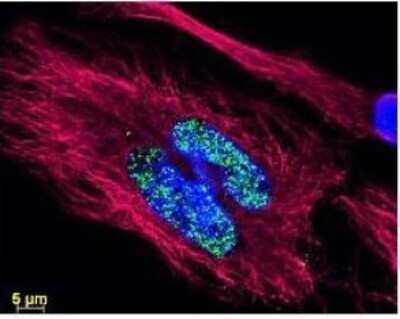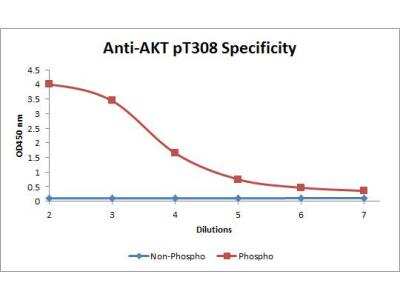AKT1 [p Thr308] Antibody (18F3.H11)
Novus Biologicals, part of Bio-Techne | Catalog # NBP1-69924


Key Product Details
Validated by
Biological Validation
Species Reactivity
Human, Mouse
Applications
ELISA, Flow Cytometry, Immunocytochemistry/ Immunofluorescence, Immunohistochemistry, Immunohistochemistry-Paraffin, Immunoprecipitation, Western Blot
Label
Unconjugated
Antibody Source
Monoclonal Mouse IgG1 kappa Clone # 18F3.H11
Concentration
Please see the vial label for concentration. If unlisted please contact technical services.
Product Specifications
Immunogen
AKT1 [p Thr308] Antibody (18F3.H11) was produced by repeated immunizations with a synthetic peptide corresponding to residues surrounding T308 of human AKT11 protein. (Uniprot: P31749)
Reactivity Notes
A BLAST analysis was used to suggest cross-reactivity with AKT1 pT308 from most vertebrate species sources based on 100% homology with the immunizing sequence. Cross-reactivity with AKT1 from other sources has not been determined. Cross-reactivity with AKT2 and AKT3 will likely occur.
Modification
p Thr308
Specificity
This antibody is specific for human and mouse AKT protein phosphorylated at T308. A BLAST analysis was used to suggest cross-reactivity with AKT pT308 from most vertebrate species sources based on 100% homology with the immunizing sequence. Cross-reactivity with AKT from other sources has not been determined. Cross-reactivity with AKT2 and AKT3 will likely occur.
Clonality
Monoclonal
Host
Mouse
Isotype
IgG1 kappa
Description
This antibody was purified from concentrated tissue culture supernate by Protein A chromatography
Store this antibody at -20C prior to opening. Aliquot contents and freeze at -20C or below for extended storage. Avoid cycles of freezing and thawing. Centrifuge product if not completely clear after standing at room temperature. This product is stable for several weeks at 4C as an undiluted liquid. Dilute only prior to immediate use.
Store this antibody at -20C prior to opening. Aliquot contents and freeze at -20C or below for extended storage. Avoid cycles of freezing and thawing. Centrifuge product if not completely clear after standing at room temperature. This product is stable for several weeks at 4C as an undiluted liquid. Dilute only prior to immediate use.
Scientific Data Images for AKT1 [p Thr308] Antibody (18F3.H11)
Western Blot: AKT1 [p Thr308] Antibody (18F3.H11) [NBP1-69924] - Lane 1: non-phosphorylated AKT in untreated cells. Lane 2: phosphorylated AKT on PDGF stimulated NIH/3T3 cell lysates. Load: 15 ug per lane. Primary antibody: AKT phospho Thr308 antibody at a 1:4000 dilution in TBS with 3% BSA, for 3 h at 4 C. Secondary antibody: peroxidase conjugated Gt-a-Mouse IgG (Fc) at a 1:40,000 dilution for 1 h at 4 C. Block: 3% BSA in TBS for 30 min at RT. Predicted/Observed size: (indicated by arrowhead at 56 kDa). Other band(s): unspecific.
Immunocytochemistry/Immunofluorescence: AKT1 [p Thr308] Antibody (18F3.H11) [NBP1-69924] - IHC-P analysis of FFPE human prostate tissue using AKT1 phospho Thr308 antibody at 20 ug/mL. Left panel: 20X magnification. Right panel: 40X magnification. Heat antigen retrieval in citrate buffer pH 6.2. Secondary antibody: streptavidin-HRP at 10 ug/mL. Antibody as precipitated red signal with hemotoxylin purple nuclear counterstain. Image using the Biotin format of this antibody.
Immunohistochemistry-Paraffin: AKT1 [p Thr308] Antibody (18F3.H11) [NBP1-69924] - IHC analysis. Detection of phosphorylated AKT phospho Thr308 in human FFPE brain cerebellum tissue (40X). AKT1 phospho Thr308 antibody was used at 20 ug/mL. The image shows strong staining of Purkinje neurons. Red: AKT1 pT308. Purple: Hematoxylin nuclear counterstain.
Applications for AKT1 [p Thr308] Antibody (18F3.H11)
Application
Recommended Usage
ELISA
1:20000
Flow Cytometry
1:1:10 - 1:1000
Immunocytochemistry/ Immunofluorescence
1:10-1:500
Immunohistochemistry
20 ug/ml
Immunohistochemistry-Paraffin
20 ug/ml
Western Blot
1:500-1:3000
Application Notes
This product is tested for ELISA, immunohistochemistry, immunoprecipitation and western blotting. Expect a band approximately 56 kDa in size corresponding to phosphorylated AKT protein by western blotting in the appropriate cell lysate or extract. This phospho-specific monoclonal antibody reacts with human and mouse AKT pT308 and shows minimal reactivity by ELISA against the non-phosphorylated form of the immunizing peptide. Specific conditions for reactivity should be optimized by the end user. Use formalin-fixed paraffin-embedded sections for immunohistochemistry. No pre-treatment of sample is required.
Formulation, Preparation, and Storage
Purification
Protein A purified
Formulation
0.02 M Potassium Phosphate, 0.15 M Sodium Chloride, pH 7.2
Preservative
0.01% Sodium Azide
Concentration
Please see the vial label for concentration. If unlisted please contact technical services.
Shipping
The product is shipped with polar packs. Upon receipt, store it immediately at the temperature recommended below.
Stability & Storage
Store at -20C. Avoid freeze-thaw cycles.
Background: Akt1
The main function of AKT is to control inhibition of apoptosis and promote cell proliferation. Survival factors can activate AKT Ser473 and Thr308 phosphorylation sites in a transcription-independent manner, resulting in the inactivation of apoptotic signaling transduction through the tumor suppressor PTEN, an antagonist to PI3-K (5). PTEN exerts enzymatic activity as a phosphatidylinositol-3,4,5-trisphosphate (PIP3) phosphatase, opposing PI3K activity by decreasing availability of PIP3 to proliferating cells, leading to overexpression and inappropriate activation of AKT noted in many types of cancer.
AKT1 function has been linked to overall physiological growth and function (2). AKT1 has been correlated with proteus syndrome, a rare disorder characterized by overgrowth of various tissues caused by a mosaic variant in the AKT1 gene in humans.
AKT2 is strongly correlated with Type II diabetes, including phenotypes of insulin resistance, hyperglycemia and atherosclerosis (2, 6).
The function of AKT3 is specifically associated to brain development, where disruptions to AKT3 are correlated with microcephaly, hemimegalencephaly, megalencephaly and intellectual disabilities (2).
References
1. Ersahin, T., Tuncbag, N., & Cetin-Atalay, R. (2015). The PI3K/AKT/mTOR interactive pathway. Mol Biosyst, 11(7), 1946-1954. doi:10.1039/c5mb00101c
2. Cohen, M. M., Jr. (2013). The AKT genes and their roles in various disorders. Am J Med Genet A, 161a(12), 2931-2937. doi:10.1002/ajmg.a.36101
3. Georgescu, M. M. (2010). PTEN Tumor Suppressor Network in PI3K-Akt Pathway Control. Genes Cancer, 1(12), 1170-1177. doi:10.1177/1947601911407325
4. Mishra, P., Paital, B., Jena, S., Swain, S. S., Kumar, S., Yadav, M. K., . . . Samanta, L. (2019). Possible activation of NRF2 by Vitamin E/Curcumin against altered thyroid hormone induced oxidative stress via NFkB/AKT/mTOR/KEAP1 signalling in rat heart. Sci Rep, 9(1), 7408. doi:10.1038/s41598-019-43320-5
5. Wedel, S., Hudak, L., Seibel, J. M., Juengel, E., Oppermann, E., Haferkamp, A., & Blaheta, R. A. (2011). Critical analysis of simultaneous blockage of histone deacetylase and multiple receptor tyrosine kinase in the treatment of prostate cancer. Prostate, 71(7), 722-735. doi:10.1002/pros.21288
6. Rotllan, N., Chamorro-Jorganes, A., Araldi, E., Wanschel, A. C., Aryal, B., Aranda, J. F., . . . Fernandez-Hernando, C. (2015). Hematopoietic Akt2 deficiency attenuates the progression of atherosclerosis. Faseb j, 29(2), 597-610. doi:10.1096/fj.14-262097
Long Name
v-Akt Murine Thymoma Viral Oncogene Homolog 1
Alternate Names
PKB alpha, PRKBA, RAC-alpha
Gene Symbol
AKT1
UniProt
Additional Akt1 Products
Product Documents for AKT1 [p Thr308] Antibody (18F3.H11)
Product Specific Notices for AKT1 [p Thr308] Antibody (18F3.H11)
This product is for research use only and is not approved for use in humans or in clinical diagnosis. Primary Antibodies are guaranteed for 1 year from date of receipt.
Loading...
Loading...
Loading...
Loading...
Loading...





![AKT1 [p Thr308] Antibody (18F3.H11) AKT1 [p Thr308] Antibody (18F3.H11)](https://resources.bio-techne.com/images/products/nbp1-69924_mouse-monoclonal-akt1-p-thr308-antibody-18f3-h11-255202313132.jpg)